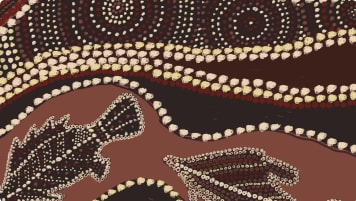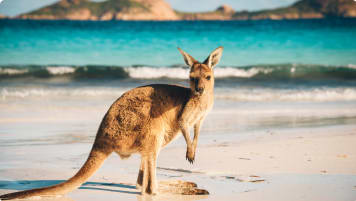How was Pituri Traded in Ancient Aboriginal Australia?
Article highlighting the ancient Aboriginal trading routes for goods and intellectual property including Pituri. This supports Odyssey's small group tours for mature and senior travellers, couples or singles interested in learning more about Aboriginal culture before touring.
5 Jun 21 · 9 mins read

Ancient Aboriginal Pituri Trade
By Marco Stojanovik
By the time European colonisation began in Australia 1788, Aboriginal people had been using and trading a leafy psychoactive plant substance called ‘pituri’ for thousands of years (Watson 2011). A highly popular commodity, pituri was traditionally used in Australian Aboriginal society on long journeys as an appetite suppressant, to sharpen the senses during important meetings, and as a painkiller in higher doses.
It is made from leaves of the narcotic shrub Duboisia hopwoodii, the most potent of Australian tobacco plant species containing nicotine and nicotiana. Aboriginal people would grind or chew one tablespoon of the pituri plant’s dried leaves and stems, which were stored in a woven bag holding larger amounts of dried plant material (Dobkin de Rios & Stachalek1999: 158). They also added alkaline ash to change the pH of the plant, facilitating the release of nicotine so it could be absorbed more readily through the mouth wall.
Sourced from the north-eastern boundaries of the Simpson Desert of West Queensland, pituri was cured, packaged, and then distributed by foot over a region of 500,000 square kilometres. Through hot and dry desert country it was passed along Aboriginal trading routes running south to Lake Eyre, north to Cloncurry and West into the Northern Territory.
Considering Australia’s lack of long, navigable rivers, one would expect such a transportation of trade goods to be extremely difficult. And with the country’s lack of a reasonable annual rainfall, combined with vast amounts of arid country, it seems practically impossible.
Anthropologist and pharmacist Pamela Watson explores the accounts of three early settlers on her blog Prehistoric Drugs: Cultural Tools to understand how Aboriginal societies overcame these problems. This article draws from her blog, as well as sources linked to throughout, to similarly explore the transportation of the substance though expeditions along shared mythological tracks, at trade centres, and during trading cycles. It is part of a continuing series of pieces on Aboriginal trade routes, art, culture, and settlement, and the ancient landscapes of Australia, intended as practical knowledge for a number of Odyssey Traveller small group tours in Australia for both the mature and senior traveller.
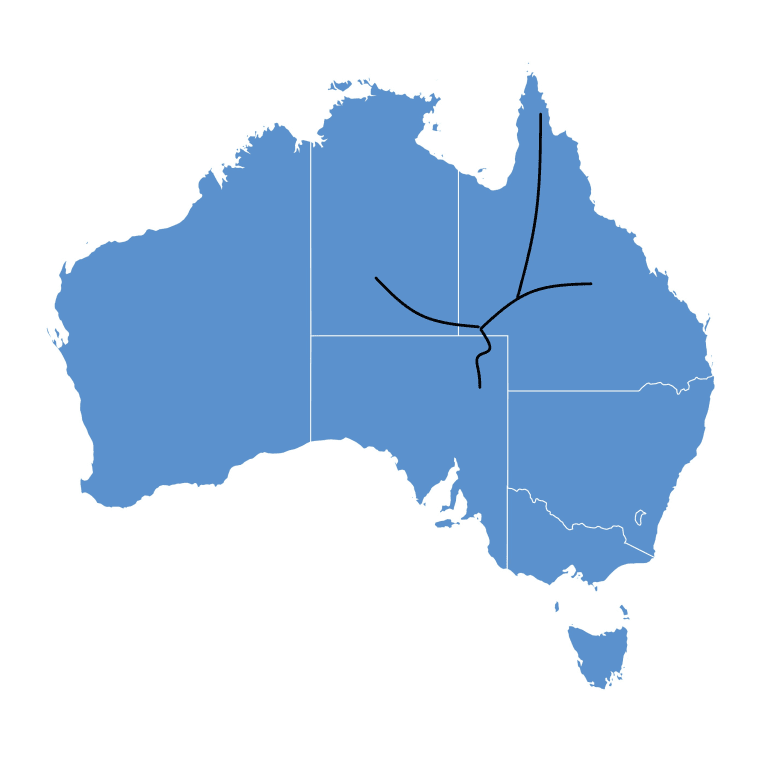
Pituri Expeditions Along Shared Mythological Tracks
In 1882 Samuel Gason, a mounted police officer stationed in Lake Eyre, reported an annual expedition of “able bodied men” from the Dieri tribe to the pituri country on the Herbert River in Queensland, i.e., the Georgina-Mulligan River basin.
Writing to Alfred William Howitt, an Australian anthropologist and pioneer authority on Aboriginal culture, Gason reported that the men travel “about 250 miles, having to pass through several hostile tribes on the journey” to trade for pituri “packed very neatly in netted bags and small wallaby skins each man carrying about seventy pounds weight”.
These netted bags have been described elsewhere as being made from the fibres of the verbena plant in the Diamantina and Georgina Rivers as well as from the broome bush that grows on sandhills (Aiston 1937: 375-6). This was twisted into string which was then dyed with red and yellow ochre and sometimes blue clay. It was woven into a semi-lunar shaped pouch, bounded closed along the curved edge, with a tassel of human hair tied at the edge of the opening as a suspension cord. Sizes varied from about six inches long to three feet.
Gason continues to explain the “great preparations” made by the tribe for the return of the pituri expedition:
“New worleys [shelters] are made, seeds of the season are stored for their fathers, brothers, husbands and friends. When such a party returned, its members were full of strange stories of battles they had fought, of tribes they had seen, men having toes behind their feet as well as in front, and all kinds of wild and extravagant reports. The pituri, although brought from so great a distance and obtained under such is all gone after a few months, being bartered away to more southern tribes.”
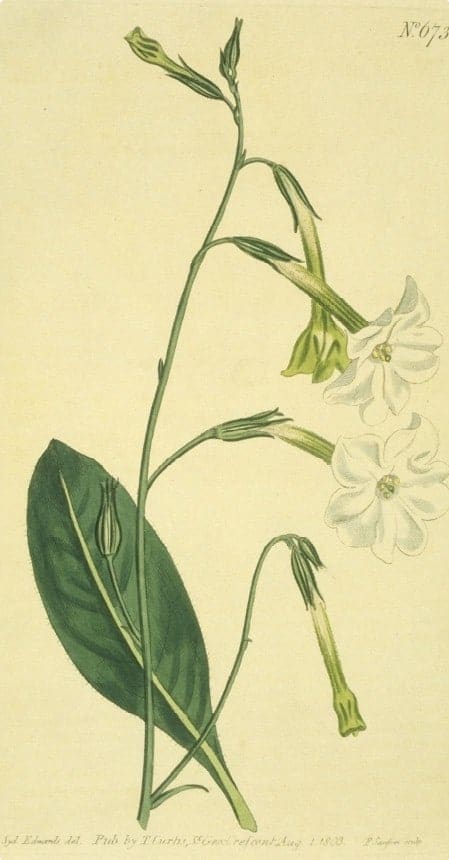
According to Watson, at least two other tribal groups in the same region also dispatched expeditions northwards to obtain the substance. All participants wore distinguished ochre body markings and carried weapons – possibly a dozen spears plus a spear-thrower and perhaps a boomerang. The necessities of food and water had to be sourced as they travelled, which would not have been an easy job in desert country.
On the men’s heads rested the vital item to be traded for the precious pituri: either slabs of sandstone rock for grinding grass and plant seeds; or “cakes” of a special red ochre, up to 70 or 80 lbs in weight when dry according to Gason, used for body point, ceremonies, and “magical charms”.
Watson explains that the participating tribes all had pituri as a clan totem and shared mythological tracks or Songlines. These tracks trace the journeys of ancestral spirits who created the land and all natural phenomena. The creation stories as well as practical knowledge needed for survival and navigation of the land are recorded in traditional music and art, which are passed down generation to generation ceremoniously at important sites and locations along the paths. Acting as a map of the land, travellers can know the route to their destination by memorising the songs.
A track may cross any number of tribal borders. However, people who belonged to the one track by birth or inheritance belonged to branches of the one cult. All belonging tribes had secret mutual claims to hospitality and protection and were normally friendly to each other. As such, traders were able to travel hundreds of kilometres following the path of their totemic hero or heroes, free and safe in territory which was not their own (Watson 2011).
Pituri Trade Centres
The Australian ethnographer and outback pioneer George Aiston provided quite a different account of pituri distribution in 1937, focusing on the centres where pituri was traded. Reporting on approximately the same geographical location as Gason, he noted the sighting of a large distributing centre at Koppermanna in South Australia, “although the pituri had probably changed hands several times before it got there” (Aiston 1937: 373).
Parties arrived here through the months of cool weather and the market was kept open all this time. Pituri was traded for stone and ochre, the trade continuing until everyone was satisfied and left for home.
Pituri came to Koppermana and other destinations from further trading centres northwards. Aiston (1937: 373) also sighted a trading place “at Annandale, on the Herbert”, i.e., the Georgina-Mulligan river system. “Crowds would be waiting… for the collectors [of pituri] to come in, and getting as much as they could, would make off to Birdsville, Bedourie, Urangangie, and down the Herbert.”
Others would be waiting at Annandale to take pituri and other goods down the Diamantina to Goyder’s Lagoon, where others in turn would also be waiting to then take it back east and west as far away as the Darling and, in good seasons, the lower Finke. Aiston (1937: 374) reported to have seen “over 500 Aborigines waiting at Goyder’s Lagoon”.
He also witnessed a trading centre at Birdsville, where people would come in “from the overland telegraph line, Innamincka, Arrabury, Durham and some from near Broken Hill” to purchase “big lots” of pituri (Aiston 1937: 376).

At the marketplaces, after everybody had rested and fed, a pituri trader would throw down a bag in front of the assembled camp to begin the bartering (Aiston: 376). Anyone who wanted to buy the bag would then throw out their items, be it boomerangs, grinding mills, or whatever he could spare for barter. If the pituri trader was offered something he wanted, he would accept it by picking it up and the buy would pick up the pituri bag to complete the transaction.
The further away from the pituri grounds, the more valuable the substance became. The closer trading camps were never big then, used only to acquire utensils and weapons needed to travel to the more profitable markets.
Ultimately though, Aiston (1937: 376) concludes that “intrinsic value had nothing to do with the sales” . A big bag of pituri could just as likely be exchanged for a single boomerang or for half a dozen boomerangs and perhaps a shield and a pirra. It was always up to what the buyer and seller needed and were willing to accept.
As an anthropologist, Watson finds Aiston’s description of pituri deeply shocking. In her profession, it is widely accepted that ‘primitive’ trade of traditional societies is organised quite different than that of the marketplace. All exchange and trade resembles gift giving, done as a way to celebrate ties to meaningful others and indicate hope and intention that these relationships will continue. “It encourages peaceful relationships, and it enlarges the number of individuals or groups who can be approached in times of need or from whom marriage partners might be sought.”
In this form of trade, it is the relationship between the two traders that matters deeply, not so much what actually is exchanged. The pituri trading described, on the other hand, consists of non-partnered exchanges, haggling, definite markets, individual traders and something approaching auctions when the product changes hands. This would suggest a more advanced from of trading than you would expect in traditional societies.
Trading Cycles
A third account of pituri trading comes from Walter Roth, an anthropologist and medicinal practitioner stationed in north-west Queensland at the turn of the twentieth century. His account consequentially comes from a different geographical location than Gason’s and Aiston’s – from the north of the pituri lands, not south of them – as he focuses on the great trading cycles held annually in north-west-central Queensland.
Roth believed these ‘walk-abouts’, in which members of Aboriginal groups rigidly followed certain traditional trade routes, only began when fresh pituri became available for trade due to the high demands. According to Roth, “local Blacks will give anything they possess for it from their women downwards”.

Similar comments have been made elsewhere:
“It [pituri] was and still is among the remnants of the Diamantina tribes the ‘gold’ standard for exchange or barter purposes. A seventy-pound bag of un-dried pituri leaf spelt untold wealth. The Murranudda and messmate tribes bartered spiritedly for bags of it and used it as currency among less fortunate messmates. The small oval bags made of human hair. containing a couple of pounds of the plant, bought two wives, husbands or many goods” (Duncan Kemp 1964:284).
Amongst Roth’s observational data is an intriguing number of participating tribes and items brought to trade and obtained in return during the great trading cycles. Items included but were not limited to pituri, pearl-shells, ornamental feathers, spears, boomerangs, stone-knives, shields, coolamons, ochre, human hair-belts, and white-men’s knives, blankets, shirts and trousers.
Watson comments that it is notable that “while the pituri trade included some raw materials such bird-feathers and shell, most components in Roth’s descriptions consist of value-added products”. Items such as stone axes, pecked grinding stones, coolamons (for storage), packaged barely seed and fish flour, for example, possessed an added labour component.
Eagle feathers and human hair belts meanwhile were valued as prestige items, and coolamons and pecked grinding stones as food technology items. And minerals (ochres and gypsum), weapons (spears and shields) and mind-altering drugs (pituri) were technological forerunners of the many goods listed on today’s international stock exchange.
These trading routes were also important in the dissemination of cultural traditions, information, and religious beliefs with rights to perform particular songs and corroborees passed along these routes (Dobkin de Rios & Stachalek 1999: 158; Watson 2011).
Tour of Aboriginal Australia
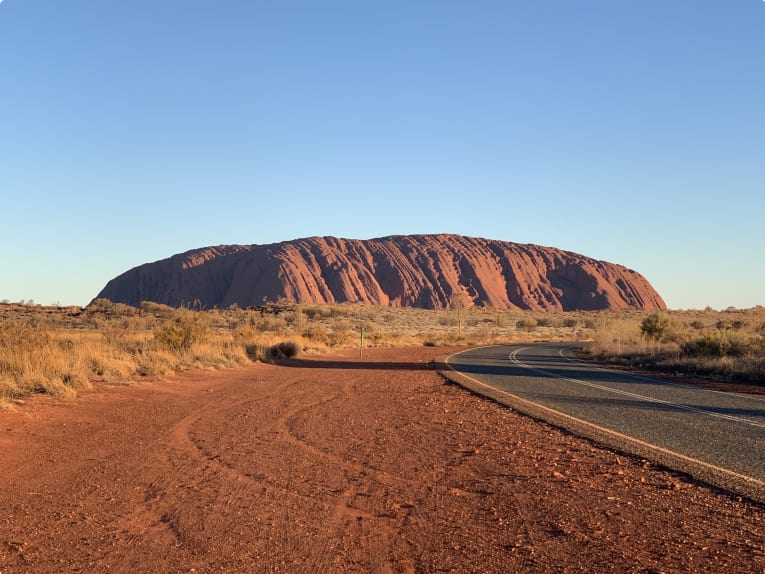
Travellers with an interest in learning more about the Aboriginal heritage of Australia may want to check out our various outback Australia tours.
These include visits to:
- Archaeological sites including the Madjedbebe rockshelter and the extensive collection of ancient Aboriginal rock art at Kakadu National Park as part of our tour of Kakadu and Darwin
- The ancient indigenous sites including Lake Mungo and the Budj Bim Cultural Landscape as part of our tour of the Southern States of Australia;
- The important cultural site of Wilpena Pound on our tour of the Flinders Ranges;
- The ancient rock art in the Kimberley, Western Australia;
- The Brewarrina Fish Traps in outback Queensland;
- Uluru and Kata Tjuta in the Northern territory.
Every Odyssey guided tour is designed especially for mature and senior travellers, who want an authentic and informed experience of their destinations. Our tours aren’t the typical tourism Australia holiday – Blue Mountains, the Great Barrier Reef, and the penguin parade on Port Phillip Island. Instead, we pride ourselves on getting of the beaten path and making you think about Australia and New Zealand in new ways. We move in genuinely small groups – usually 6-12 per tour – and all tours are cost-inclusive, encompassing accommodation, attraction entries, and transport. For more information, click here, and head to this page to make a booking.
Articles about Australia published by Odyssey Traveller:
- The Kimberley: A Definitive Guide
- Uncovering the Ancient History of Aboriginal Australia
- Aboriginal Land Use in the Mallee
- Understanding Aboriginal Aquaculture
- Mallee and Mulga: Two Iconic and Typically Inland Australian Plant Communities(By Dr. Sandy Scott).
- The Australian Outback: A Definitive Guide
- The Eyre Peninsula: Australia’s Ocean Frontier
- Archaeological mysteries of Australia: How did a 12th century African coin reach Arnhem Land?
For all the articles Odyssey Traveller has published for mature aged and senior travellers, click through on this link.
External articles to assist you on your visit to Australia:
- John Mulvaney: ‘… these Aboriginal lines of travel‘
- Queensland Historical Atlas: Aboriginal dreaming paths and trading ways
- National Museum Australia: Trade with the Makasar
- Fish traps and stone houses: New archaeological insights into Gunditjmara use of the Budj Bim lava flow of southwest Victoria over the past 7000 years
- Isabel McBryde: Exchange in south eastern Australia
- Shells, not pearls, were the real prize in traditional Aboriginal culture
We acknowledge Aboriginal and Torres Strait Islander peoples as the First Australians and Traditional Custodians of the lands where we live, learn and work. We pay our respects to Elders past, present and emerging.
Related Tours

days
Apr, May, Jun, Jul, Aug +3Small group tour exploring Alice Springs and Uluru-Kata Tjuta National Park
Visiting Northern Territory
Explore and learn about historic Alice Springs, The MacDonnell ranges, and Uluru-Kata Tjuta National Park. This escorted small group tour for mature and senior travellers, travelling as a couple or solo travellers also visits the Hermannsburg Lutheran mission plus Henbury meteorite site learning about the Aboriginal outback and contemporary art.

days
Apr, Jun, Aug, Nov, Mar +2Exploring Alice Springs and Uluru-Kata Tjuta National park by Motorbike
Visiting
Explore on a Motorbike tour in the Outback and learn about historic Alice Springs, The MacDonnell ranges, and Uluru-Kata Tjuta national park. This escorted small group Motorbike tour for mature and senior travellers, travelling as a couple or solo travellers also visits the Hermannsburg Lutheran mission plus Henbury meteorite site learning about the Aboriginal outback and contemporary art.

days
Jun, Jul, Sep, Feb, Mar +1Darwin and Kakadu small group tour
Visiting Northern Territory
Explore and learn as part of a small group tour for seniors on this package tour to Darwin and Kakadu National park, a UNESCO world heritage site. This program also visits Arnhem land. Our focus is on ecology, landscapes and history on this 14 day program in the far north of the Northern Territory.
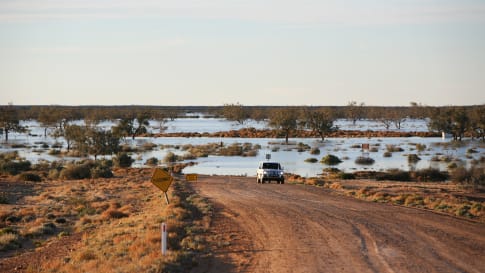
65 days
MarLong tour of Australia for a small group
Visiting New South Wales, Northern Territory
Small group tour for senior couples and solo travellers touring Australia. Travelling through the outback and visiting many of the famous sights as well as off the beaten track locations. Learn about the history of the people who explored the deserts, from indigenous communities to Europeans, as well as Burke and Wills, visit White Cliffs, Marree and far north Kakadu and the Kimberley.
From A$48,995 AUD
View Tour
13 days
May, Jun, Jul, Aug, SepSmall group tour of Australia's Kimberley
Visiting Western Australia
Escorted small group tour of the Kimberley. We explore and visit The Bungles, Bell Gorge, Mitchell plateau & Halls Creek in the dry season. Amazing landscapes intertwined with Aboriginal communities resident more than 45,000 years.
From A$15,390 AUD
View Tour
days
Mar, May, Aug, Sep, Oct +2Small group tour of World Heritage sites and more in the Southern States of Australia
Visiting New South Wales, South Australia
Discover the World Heritage Sites of the southern states of Australia travelling in a small group tour. A journey of learning around the southern edges of the Murray Darling basin and up to the upper southern part of this complex river basin north of Mildura. We start and end in Adelaide, stopping in Broken Hill, Mungo National Park and other significant locations.

days
Feb, Mar, May, Jul, Sep +2Guided small group motorcycle tour of World Heritage sites in Victoria and South Australia
Visiting
Discover the World Heritage Sites of the southern states of Australia travelling in a small group tour of like minded motorcyclists. A journey of learning around the southern edges of the Murray Darling basin and up to the upper southern part of this complex river basin north of Mildura. We start and end in Adelaide, stopping in Broken Hill, Mungo National Park and other significant locations.
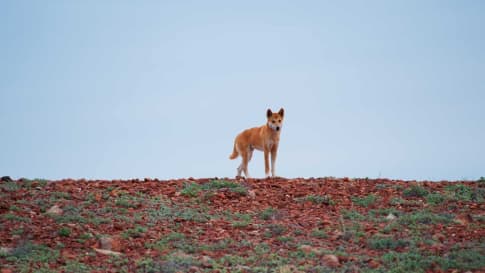
days
Apr, May, Jul, Aug, Oct +2Small group tour of Australia's Flinders ranges
Visiting South Australia
Escorted small group tour of the Flinders range in South Australia from Adelaide. Learn about Coober Pedy, Wilpena pound and water system of Lake Eyre as we explore and learn also about the history of the people who explored the Flinders.
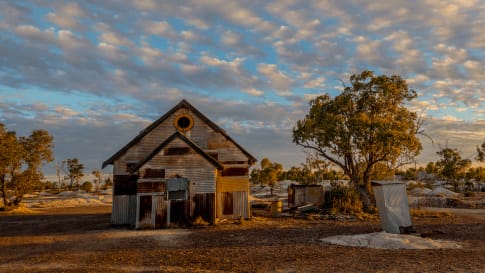
days
Mar, Apr, May, Jul, Aug +2Small group tour of outback Queensland
Visiting New South Wales, Queensland
To Dubbo and back, this small group tour takes you to learn about the Brewarrina fish traps, we travel high up into North Queensland to see the Dinosaurs of Winton and incredible Aboriginal rock art at Cathedral gorge and learn about opal mining and the history of Lightning ridge.
Articles
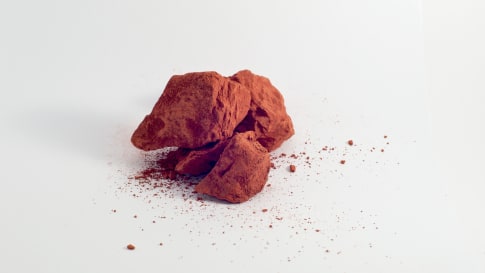
Aboriginal Ochre Trade
Article for small group travellers to learn about ochre in the historic Aboriginal community of outback Australia. Mature and senior travellers explore the deep history and trading routes of Aboriginal History.
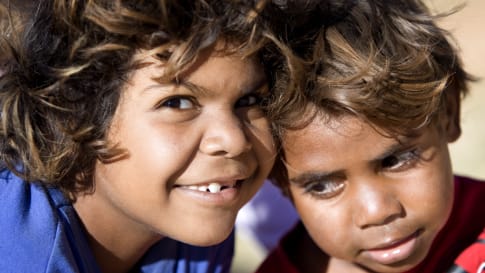
Aboriginal Songlines
Songlines trace the journeys of ancestral spirits who created the land and all natural phenomena. The creation stories as well as practical knowledge needed for survival in outback Australia. We experience this knowledge on our small group tours into Outback Australia.

Ancient Aboriginal trade routes of Australia
Ancient Aboriginal trade routes of Australia Trade was a central part of life for Aboriginal people prior to the British settlement of Australia. Trading routes criss-crossed the nation, dispersing goods, information, technologies and culture thousands…
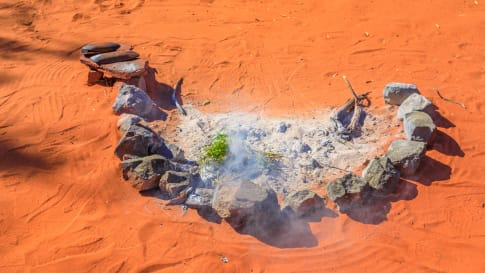
Australian Aboriginal Paths of Migration
Article for small group tours of mature or senior couples or solo travellers interested in learning more about Aboriginal history, Kinship, trading routes, songlines and ancient history.

Bora Rings: Ancient Aboriginal Ceremonial Grounds
Article for mature and senior travellers, couple or solo joining an Aboriginal history small group tour of Australia. Small groups of like minded people exploring outback Australia, colonial history and Landscapes.

The Arrival of Aboriginal Australians on the Continent
Tracing Aboriginal history via an outback small group tour for mature and senior couples or solo travellers provides an intriguing learning platform about Australia, rock art, trading and culture that traces a history possibly some 120,000 years ago.

The Australian Outback: A Definitive Guide
Explore learn and consider what is the outback in this article. For mature and senior travelers considering joining a small group package tours into the outback to see, learn and explore about this unique place, not only the landscape but the Aboriginal approach to living. On each of the tours for couples and the single traveler you learn something different but fascinating, from Outback Queensland, the Flinders, Broken Hill and the Kimberley and the wildflowers all contribute to this question, what is the outback?
